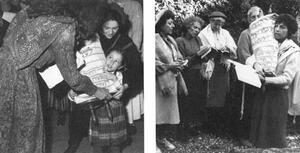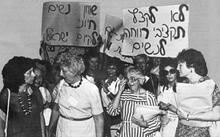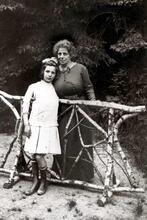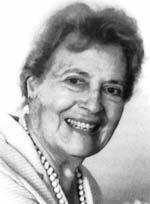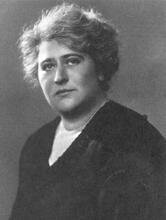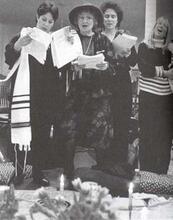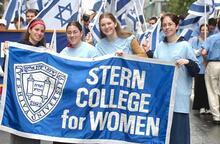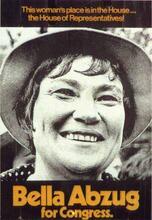American Jewish Congress
In 1933, Louise Waterman Wise founded the Women’s Division of the American Jewish Congress. During the 1930s and 1940s, members of the Women’s Division dedicated themselves to helping the victims of Nazi aggression in Europe. After 1948, AJCongress women turned their energies toward the new State of Israel, sending aid and eventually sponsoring tours for AJCongress members. The Women’s Division continued to advocate for civil rights and women’s rights in the United States and worked to preserve Jewish American culture until the division was discontinued after approximately fifty years. The AJCongress’s support for women’s rights and feminism within the Jewish community has continued under the auspices of the Commission for Women’s Equality, which was founded in 1984.
Women in the American Jewish Congress’ Early Years
Women have played an important part in the American Jewish Congress (AJCongress) since the organization was first established after World War I. American Jewish leaders originally convened a Jewish Congress in December 1918 in order to represent the interests of the war-torn Jewish communities of Eastern Europe at the postwar peace conference. Although AJCongress organizers hoped to create a vehicle of American Jewish unity, from the outset the AJCongress movement drew its strongest support from the ranks of American Zionism and from within the Eastern European immigrant community. This constituency probably contributed to the AJCongress’s acceptance of women’s involvement. While women in the more established and genteel German Jewish community tended to conform to the same model of middle-class domesticity as their non-Jewish counterparts, many Jewish women from Eastern Europe arrived in the United States with a tradition of active participation in the marketplace, the family economy, and the politics of the Jewish labor movement.
The leadership of the AJCongress also helped to encourage women’s participation. Fully committed to the democratic idealism of progressive politics, AJCongress leaders such as Rabbi Stephen S. Wise and Louis D. Brandeis were strong supporters of women’s rights, especially female suffrage. Moreover, as champions of greater democracy in Jewish communal life, AJCongress advocates could not have excluded women without provoking accusations of hypocrisy. These commitments were evident during the election of Jewish Congress delegates in 1917, in which Jewish women enjoyed the right to vote and to run as candidates—three years before American women gained the unrestricted right to vote under the Nineteenth Amendment.
The original American Jewish Congress was disbanded in 1920, after receiving the report of its delegation to the peace conference in Versailles. Immediately thereafter, the organization was reestablished on a permanent basis under the leadership of Stephen S. Wise. During the 1920s, the AJCongress devoted most of its modest resources to aiding Eastern European Jewry and advancing the Zionist cause.
Founding of the Women’s Division
The rising tide of political antisemitism in Europe and the United States during the 1930s brought new challenges for the AJCongress, which quickly joined other American Jewish communal organizations in the fight against fascism. Early in this critical decade, in 1933, Louise Waterman Wise founded the Women’s Division of the American Jewish Congress. Like her husband, Stephen, Louise Wise was a leader of the AJCongress and a progressive reformer. In 1914, she had organized the Child Adoption Committee of the Free Synagogue, the first agency specializing in Jewish adoptions. The Women’s Division she established and led was dedicated to the same objectives as the general division of the American Jewish Congress: the protection of Jewish rights at home and abroad, the advancement of American democracy, the elimination of racial and religious discrimination in the United States, the enhancement of Jewish identity, and the promotion of Zionism.
Many of the officers and members of the Women’s Division were married middle-class women who worked outside the home as unpaid volunteers. Louise’s daughter, Judge Justine Wise Polier, who became president of the Women’s Division shortly after her mother’s death in 1947, was an exception. She enjoyed a long and successful judicial career on the benches of the Domestic Relations Court of New York City and the New York State Family Court, skills that she brought to her work in the Women’s Division. While the New York metropolitan area and its environs remained the center of organization and leadership, over the years AJCongress women launched local chapters in a wide range of cities, including Albany, Hartford, Philadelphia, Cleveland, Cincinnati, Indianapolis, Chicago, Detroit, Los Angeles, Miami Beach, St. Louis, Baltimore, Washington, D.C., and Norfolk, Virginia, in turn enabling women across the country to engage in its various anti-fascist, anti-Nazism, pacifist, pro-Israel, and both women’s and Black civil rights programs. During the postwar period, when increasing numbers of American Jews left the cities for the suburbs, chapters of the Women’s Division blossomed in the bedroom communities outside of New York City, Boston, Newark, and other urban centers.
Even before the 1930s and 1940s, members of the Women’s Division dedicated themselves to helping the victims of Nazi aggression in Europe. They focused on the growth of fascism, antisemitism, and anti-Jewishness in the United States, working on the grassroots level to protest Father Coughlin—a Roman Catholic priest who gained a mass following on the airwaves for his weekly radio sermons that, among other things, viciously libeled and disseminated dangerous propaganda about Jews—and form inter-religious coalitions to fight against bigotry. After Hitler came to power in Germany, Louise Waterman Wise transformed three townhouses owned by the Jewish Institute of Religion into refugee houses, which furnished food, temporary shelter, educational programs, and other necessities of life to thousands of Jews fortunate enough to reach the United States. The Women’s Division did not simply await refugees who managed to escape Nazi Germany; rather, it actively assisted them in getting out. Through a combination of local campaigns and work with governmental officials, members used their collective might to espouse the cause of Jewish refugees, particularly children. Among their primary methods, they both signed and assisted others in signing affidavits guaranteeing that these Jews would not become public charges, or so-called “burdens” on taxpayers’ dollars due to physical, mental, or economic condition—the primary reason the United States did not accept more German Jewish refugees during the Hitler years, as the German immigration quotas never filled between 1933 and 1939. Members publicized the need for both Jewish and non-Jewish Americans to put their names to these affidavits and provided support in completing these bureaucratic forms.
Meanwhile, the Women’s Division mobilized its Legislative Action Committee to raise awareness about the plight of European Jewry, involving both politicians and the public in its campaigns. These efforts included authoring and publishing articles in AJCongress’s Congress Bulletin explaining why imminent legislation warranted support or obstruction. Concurrently, Justice Justine Wise Polier worked hand-in-glove with Eleanor Roosevelt through the Interim Committee of the Non-Sectarian Committee for Jewish Refugee Children, seeking bipartisan commitment from Congress to circumnavigate stringent immigration restrictions. Alongside Cecilia Razovsky, a leader in immigration policy from the National Council of Jewish Women, Polier emphasized the hazard that Nazism posed to Jewish children. To this end, the Women’s Division highlighted the Wagner-Rogers Bill, which would have admitted thousands of German Jewish children into the United States. The Bill found support beyond AJCongress, backed by Secretary of Labor Frances Perkins and First Lady Eleanor Roosevelt at the highest levels of the federal government. To Polier’s profound devastation, the bill ultimately failed in Congress. Shortly thereafter, she and her husband adopted a German Jewish refugee child.
Beginning in 1939, Women’s Division volunteers sewed and knitted clothing and blankets for refugees, wounded soldiers, and civilians in Europe. AJCongress women also helped to administer a foster parent program, through which American Jews could help to provide food, clothing, and medical care to Jewish children in Europe who had lost one or both parents during the war. In order to support the American military effort, Women’s Division members sold United States war bonds. In addition, after the Japanese attack on Pearl Harbor, one of the refugee houses in New York City was converted into a defense center, which offered accommodations, meals, recreation, and training courses to American servicemen.
Less well known, the Women’s Division also did the vast majority of the ground-level work of AJCongress’s consumer boycott of German-manufactured products. By 1934, as the boycott endeavors waned, the Women’s Division took over and refashioned boycott organizing, thanks in significant part to its local focus, understanding of industry and consumer pattern, and ability to communicate actionable information about the boycott to purchasers in outlying areas. As members conceptualized the boycott, it served a tripartite purpose. Not only would it, they hoped, defend European Jews, it would also both bolster American democracy and combat the threat fascist governments posed to the rights of women. Managing the boycott on an everyday level, members of the Women’s Division took on the operational leadership and coordination to promote the boycott’s continuity, using their local communities as their home bases. They organized consumers—usually women themselves, who did the regular shopping for their households—and, for the first time in this boycott, implemented and coordinated picket lines in front of businesses. The labor of AJCongress women facilitated their entry into public speaking and the ranks of community organizers. Their boycott work inspired numerous women to become active in AJCongress and other Jewish organizations in opposition to the Hitler regime.
The State of Israel
After 1948, AJCongress women turned their energies toward the new State of Israel. In cooperation with the Israeli government, the Women’s Division sent large shipments of toys and educational materials to the Jewish state, where these goods were in short supply. Women’s Division members across the United States continued to produce clothing, which helped to clothe young Israeli immigrants. By the end of the 1950s, when this effort was superseded by the growing strength and productivity of the Israeli textile industry, AJCongress women proudly claimed to have shipped over 90,000 children’s garments to Israel. Women’s Division members also worked on behalf of the Jewish state by selling tens of thousands of dollars worth of Israel Bonds and playing a prominent role in the annual campaigns of the United Jewish Appeal.
At the same time, AJCongress women sought a direct and personal connection with the Jewish state that material aid and fund-raising could not supply. In 1954, the AJCongress Women’s Division established the Louise Waterman Wise Youth Center in Israel. The youth center, intended as a memorial to the founder of the Women’s Division and her lifelong dedication to child welfare and Jewish nationalism, was constructed in western Jerusalem, not far from the grave of Theodor Herzl. Working closely with Israeli officials, the youth center offered special programs designed to help new immigrants adjust to Israeli society. Young Jews originally from North Africa received special instruction in English, mathematics, and other subjects under the center’s auspices. In addition, the center furnished lodging for American Jews visiting Israel, provided leadership training for young Israelis, and housed educational and cultural projects for Jewish and Arab youth. Within a relatively short time, the programs of the Louise Waterman Wise Youth Center expanded to include thousands of Israelis and non-Israelis each year.
During the late 1950s and early 1960s, the Women’s Division began to sponsor tours to Israel for AJCongress members and their families. These trips, like the youth center, were designed to strengthen the emotional bonds between AJCongress members and the people and land of Israel. Participants in the Women’s Division tours met Israelis from all walks of life, including government officials, educators, well-known cultural figures, and leaders of the Arab community. Their itinerary included visits to A voluntary collective community, mainly agricultural, in which there is no private wealth and which is responsible for all the needs of its members and their families.kibbutz, schools and universities, the Lit. "assembly." The 120-member parliament of the State of Israel.Knesset, factories, Arab and Druze villages, and a wealth of religious and archaeological sites. Women’s Division members especially enjoyed the opportunity to observe the programs of the Louise Waterman Wise Youth Center on a firsthand basis. In addition, these trips generally included excursions to a series of European cities, where AJCongress members toured sites of Jewish historical and cultural importance and conferred with European Jewish leaders. Women’s Division leaders hoped that these personal interactions with Israeli and European Jews would enhance AJCongress members’ commitment to the concept of klal Yisrael, or Jewish peoplehood.
As devoted Zionists, AJCongress women took direct action when they perceived a threat to Israel. During the 1964–1965 World’s Fair in New York City, AJCongress members, including Women’s Division vice president Jacqueline Levine, were arrested for picketing an anti-Israel mural at the Jordan Pavilion. After the Six-Day War in 1967, as American Jews became even more ardently committed to assuring Israel’s safety, Women’s Division officials concerned themselves with battling the influence of anti-Israel propaganda on Jewish college students. At the same time, the Women’s Division called for negotiations between Israel and its Arab neighbors aimed at establishing a permanent peace in the Middle East.
Civil Rights and Civil Liberties
On the home front, the leaders and members of the Women’s Division dedicated themselves after 1945 to advancing the AJCongress’s liberal civil rights program. During the late 1940s and 1950s, AJCongress women organized rallies to muster public support for the enactment of state legislation against discrimination in employment, public accommodations, and education. Justine Wise Polier and other Women’s Division officials assumed leadership positions in national and New York state committees established to fight residential segregation. Women’s Division members were also active in state and local civic organizations dedicated to eliminating racial discrimination in the public schools. During the early and mid-1960s, officers and members of the Women’s Division took part in civil rights marches and lent material support to the African-American civil rights organizations leading the freedom struggle in the Deep South. In communities across the country, AJCongress women worked through local school boards and civic organizations to implement tutoring, job placement, and voter registration programs.
Women’s Division members similarly lent their strength to the AJCongress’s campaign to expand protection for civil liberties. During the postwar anticommunist crusade, local chapters of the Women’s Division sponsored demonstrations to protest measures, such as the McCarran-Walter Immigration Act (1952), which violated fundamental principles of due process. Women’s Division members were especially active in their local communities as champions of the AJCongress’s fight to keep the public schools free from religious sectarianism. During the early 1950s, Women’s Division members in New York mobilized parents, community activists, and civic organizations against the state’s program of released-time religious instruction. While they were ardent supporters of federal aid to education, AJCongress women instigated letter-writing drives against measures that extended federal support to parochial schools or otherwise conflicted with strict separation between church and state.
So too, members of the Women’s Division participated in Black civil rights efforts. Shirley Zoloth, decidedly on the left in her progressive activism, began her sociopolitical reform efforts in the world of socialist labor politics. Upon moving to Miami in 1954, Zoloth initially emphasized pacifism in her advocacy work, but as she became increasingly aware of Jim Crow laws in light of the Supreme Court’s Brown verdict, she plunged into the efforts to integrate schools with the support of CORE (the Congress of Racial Equality). Encouraging Jewish leftists to participate in ongoing interracial movements, Zoloth drew attention to the daily indignities and brutalities that Black people suffered. Simultaneously, she participated in multiple organizations—Jewish and non-Jewish—including the Women’s Division. Her dedication to racial justice and maternalist ideology (the notion dating from the Progressive Era that women supposedly had an innate ability and responsibility to nurture and care for society beyond the confines of the home) continued to drive her political activism.
Peace Efforts
In conjunction with its commitment to civil liberties, the Women’s Division of the American Jewish Congress maintained a long tradition of involvement in issues of peace and international relations. Like their counterparts in the AJCongress’s general division, Women’s Division members were stalwart supporters of the United Nations. Women’s Division representatives worked closely with the American Association for the United Nations and lobbied the United States Government to ratify various UN treaties and conventions, especially those that promised to protect human rights. During the 1960s and 1970s, the Women’s Division helped to organize letter-writing campaigns against nuclear testing, the arms race, and the antiballistic missile program, and urged that tax dollars allocated for nuclear weapons development be redirected toward education and other domestic social programs. At the same time, AJCongress women became increasingly concerned about the persecution of Jews in the Soviet Union. Beginning in the mid-1960s, Women’s Division leaders and other AJCongress officials took an active part in conferences, protest rallies, and mass meetings designed to focus attention on Soviet antisemitism. In cooperation with other organizations, the Women’s Division pressured the United Nations to consider Soviet antisemitism as a human rights issue.
Their commitment to international peace and human rights prompted many AJCongress women to become vocal opponents of the war in Vietnam. Beginning in the mid-1960s, the Women’s Division issued a series of resolutions calling for peace. Members of the Women’s Division, including Jacqueline K. Levine, who chaired the AJCongress’s National Peace Committee, played an important part in the agency’s antiwar efforts. Leaders of the Women’s Division urged AJCongress members to write letters to President Lyndon B. Johnson, members of Congress, and United Nations ambassador Arthur Goldberg protesting the bombing campaigns in Vietnam and calling for an end to the war. In 1967, the Women’s Division collaborated with the Americans for Democratic Action and SANE in a petition drive demanding peace negotiations. Women’s Division members, including the organization’s top leadership, took part in numerous antiwar demonstrations throughout the duration of the war.
Women’s Equality
During the 1960s and 1970s, partly as a result of their participation in the civil rights and antiwar movements, AJCongress women joined in the fight for women’s equality. Since the 1930s, the Women’s Division had served as an effective vehicle for social and political action. Its members, however, had consistently emphasized that their particular role was to build support for AJCongress policies and programs on the community level, through local school boards, as participants in parent-teacher associations, and especially in their capacity as mothers. By the 1960s, women within the AJCongress—like women active in other Jewish community organizations—increasingly rejected this separate sphere and demanded equal power and responsibility in Jewish communal life. In 1966, Women’s Division president Virginia Snitow led a successful effort to gain a small but significant increase in representation for Women’s Division members on the AJCongress Executive Committee. At the same time, Women’s Division leaders, including Virginia Snitow and Jacqueline K. Levine, called for greater women’s participation in other communal agencies, such as the President’s Conference of Major Jewish Organizations and the Council of Jewish Federations and Welfare Funds (CJFWF), which were largely, if not entirely, male-dominated.
AJCongress women faced several obstacles, however, in their struggle for equality within the Jewish community. First, positions of authority were frequently awarded to wealthy donors, who tended to be successful businessmen. Second, some women were ambivalent about their traditionally separate position within the American Jewish Congress and the organized Jewish community as a whole. While women activists increasingly wanted to play an equal part in the policy-making process, some were reluctant to sacrifice the valuable ties they had established within separate women’s divisions, auxiliaries, and organizations. Over time, however, Jewish leaders came to recognize that it would be difficult to attract younger Jews—both women and men—to communal organizations segregated by sex, and that the relegation of women to separate auxiliaries directly contravened the principles of liberty and equality upon which their agencies were founded. As a result, beginning in the 1970s, efforts were made to bring greater numbers of women into leadership positions within Jewish communal organizations. In 1972, Naomi B. Levine, who had previously served on the AJCongress’s legal staff and as director of the Women’s Division, became the agency’s first female executive director. Jacqueline K. Levine, who began her long career in Jewish communal service by joining the AJCongress Women’s Division, moved on to leadership positions with the AJCongress, the CJFWF, and the National Jewish Community Relations Advisory Council.
Women within the AJCongress also pushed the organization to take a strong stand in support of women’s rights within the broader society. Starting in the late 1960s and early 1970s, the Women’s Division issued resolutions from its biennial conventions that called for the total elimination of discrimination against women in employment, education, housing, politics, civil law, and jury service. The Women’s Division advocated strong enforcement of the 1964 Civil Rights Act, which prohibited discrimination by sex as well as by race, and demanded the enactment of state laws mandating equal pay for equal work and the passage of an Equal Rights Amendment to the United States Constitution. Both the Women’s Division and the AJCongress as a whole took an uncompromising position in favor of reproductive freedom. AJCongress officials called for the repeal of all laws restricting women’s right to choose and took special note of the unfair impact of anti-abortion laws on poor women. After the Supreme Court decided Roe v. Wade (1973), AJCongress leaders expressed their strong approval of the ruling and testified before Congress against measures intended to nullify the decision. In more recent years, the AJCongress has joined with other Jewish communal and religious organizations in political demonstrations in defense of reproductive rights.
Jewish Identity
Throughout the postwar period, AJCongress women worked to sustain Jewish identity and culture. During the 1940s and 1950s, the AJCongress sponsored studies to determine the most effective methods for helping Jewish children to develop psychologically sound self-images despite the presence of antisemitism in American culture. Programs developed by the Women’s Division emphasized mothers’ responsibility for transmitting Jewish values to their children. Members of local chapters organized study groups, holiday parties, music festival,s and other special activities dedicated to celebrating and imparting Jewish history and culture. Even as they became more active in the broad social movements of the 1960s and 1970s, AJCongress women confirmed their long-standing commitment to Jewish continuity. In the late 1960s, the Women’s Division, the AJCongress’ Commission on Jewish Affairs, and the Herzl Institute cosponsored a School for Jewish Parent Education, one of several programs designed to stem the tide of assimilation among Jewish youth by providing instruction in Jewish religion, history, music, and art.
The End of the Women’s Division and Beyond
The Women’s Division was discontinued as a separate section after approximately fifty years of service. The AJCongress’s support for women’s rights and feminism within the Jewish community has continued, however, into more recent decades. Under the leadership of groundbreaking feminist Betty Friedan, who authored the watershed Feminist Mystique published in 1963, it established the Commission for Women’s Equality in 1984, at a time when no other mainstream Jewish organization that did not focus solely on women’s issues prioritized women’s rights. The Commission’s leadership included notable women such as former congresswomen and pioneering LGBTQ-rights champion Bella Abzug; activist and co-founder of Ms. Magazine Letty Cottin Pogrebin; former congresswoman and later New York City Comptroller Elizabeth Holtzman; and Ann Lewis, who would soon accept the role of Vice President for public policy at Planned Parenthood and serve in multiple leading positions in the Democratic Party, including Director of Communications to President Bill Clinton and senior advisor for Hillary Clinton’s 2008 presidential campaign. Among its many projects, the Commission has worked to create an international network of Jewish feminists, to serve as a vocal advocate for abortion rights, and to raise consciousness within the Jewish community about domestic violence, pay equity, and other issues of particular importance to women. Feminist Centers established by the AJCongress in various cities have become a forum for exploring women’s equality within the Jewish religious context.
Alperin, Michele. “An Image of Israel: Jewish Feminists Discuss Ms. Magazine vs. American Jewish Congress.” Bridges, Vol. 13, No. 2 (Autumn, 2008): 4-19.
Baum, Charlotte, Paula Hyman, and Sonya Michel. The Jewish Woman in America. New York: Dial, 1975.
Cohen, Steven M., Susan Dessel, and Michael Pelavin. “The Changing (?) Role of Women in Jewish Communal Affairs: A Look into the UJA.” In The Jewish Woman: New Perspectives, edited by Elizabeth Koltun. New York: Schocken, 1976.
EJ, s.v. “American Jewish Congress” and “Wise, Stephen Samuel”.
Fishman, Sylvia Barak. A Breath of Life: Feminism in the American Jewish Community. New York: Free Press, 1993.
Frommer, Morris. “The American Jewish Congress: A History, 1914–1950.” 2 vols. Ph.D. diss., Ohio State University, 1978.
Glanz, Rudolph. “The Eastern European Jewish Woman.” In The Jewish Woman in America: Two Female Immigrant Generations, 1820–1929. Vol. 1. Ktav, 1976.
Katz, Elizabeth D. “Racial and Religious Democracy”: Identity and Equality in Midcentury Courts. Stanford Law Review, Vol. 72 (June 2020): 1467-1579.
Kuzmack, Linda Gordon. Woman’s Cause: The Jewish Woman’s Movement in England and the United States, 1881–1933. Columbus, OH: Ohio State University Press, 1990.
Marcus, Jacob Rader. The American Jewish Woman: A Documentary History. Ktav, 1981.
Mohl, Raymond A. “Some of Us Were There before Betty: Jewish Women and Political Activism in Postwar Miami.” In A Jewish Feminine Mystique? Jewish Women in Postwar America, edited by Rachel Kranson, Shira M. Kohn, and Hasia R. Diner, 13-30. New Brunswick: Rutgers University Press, 2010.
Pogrebin, Letty Cottin. Deborah, Golda, and Me. New York: Crown, 1991.
Sheramy, Rona. “There are Times When Silence is a Sin”: The Women’s Division of the American Jewish Congress and the Anti-Nazi Boycott Movement. American Jewish History, Vol. 89, No. 1 (March 2001): 105-121.
Svonkin, Stuart. “Jews Against Prejudice: American Jews and the Intergroup Relations Movement from World War to Cold War.” Ph.D. diss., Columbia University, 1995.
Urofsky, Melvin I. A Voice That Spoke for Justice: The Life and Times of Stephen S. Wise. Albany: SUNY Press, 1982.
Waldman, Lois. Telephone interview with Stuart Svonkin, August 29, 1995.
Women’s Division of the American Jewish Congress. Papers. American Jewish Historical Society, Waltham, Mass.
Zucker, Bat-Ami. “Frances Perkins and the German-Jewish Refugees, 1933-1940.” American Jewish History, Vol. 89, No. 1 (March 2001): 35-59.

